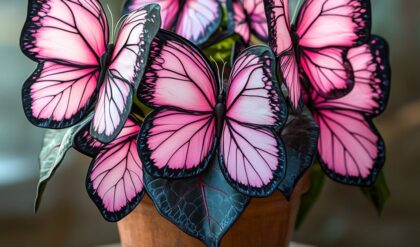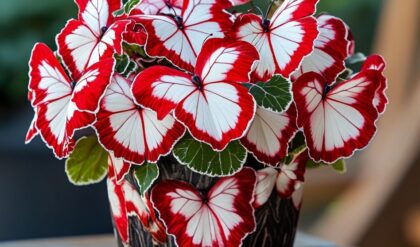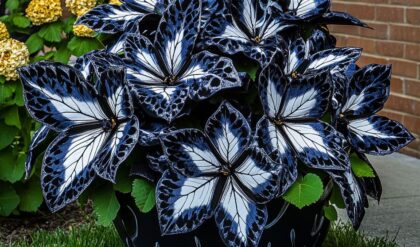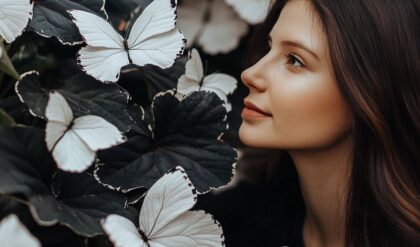Caladiums, with their vibrant and heart-shaped leaves, are more than just a delightful addition to gardens; they represent a profound connection to tropical ecosystems that can inspire admiration and respect for nature. Originating from the lush forests of South and Central America, these plants thrive in conditions that mimic their native habitat—moist, warm environments shielded from harsh sun. This adaptability makes them a beloved choice for gardeners looking to infuse color into shaded areas or enhance borders with their striking foliage.

Introduction to Caladiums
Overview of Caladium Characteristics
Caladiums are renowned for their stunning foliage, which comes in a wide array of colors and patterns. These tropical perennials are primarily grown for their large, heart-shaped leaves that can display combinations of green, white, pink, and red. The leaves emerge from underground tubers and can reach heights of 12 to 30 inches, depending on the variety.
The intricate patterns on caladium leaves are often described as painterly, with veins of contrasting colors creating stunning effects. Some varieties feature bold central veins, while others showcase speckled or mottled patterns that resemble abstract art. This diversity in leaf appearance allows gardeners to create dynamic and visually interesting landscapes.
Caladiums are typically grown as annuals in temperate climates but can be perennial in tropical and subtropical regions. Their ability to thrive in shaded areas makes them invaluable for brightening up dim corners of gardens where other colorful plants might struggle.
Historical Significance and Origin
The history of caladiums traces back to the Amazon Basin and the tropical regions of South and Central America. Indigenous peoples have long appreciated these plants for their beauty and potential medicinal properties. European explorers first encountered caladiums in the 18th century, and by the 19th century, they had become popular ornamental plants in European and North American gardens.
The scientific name Caladium bicolor was given by botanist Étienne Pierre Ventenat in 1801, though this nomenclature has since been revised. The genus Caladium belongs to the family Araceae, which includes other popular ornamental plants like philodendrons and peace lilies.
Throughout the 19th and 20th centuries, horticulturists and plant breeders developed numerous cultivars, expanding the range of colors and patterns available. This breeding work has resulted in the vast array of caladium varieties we see today, each with its own unique charm and characteristics.
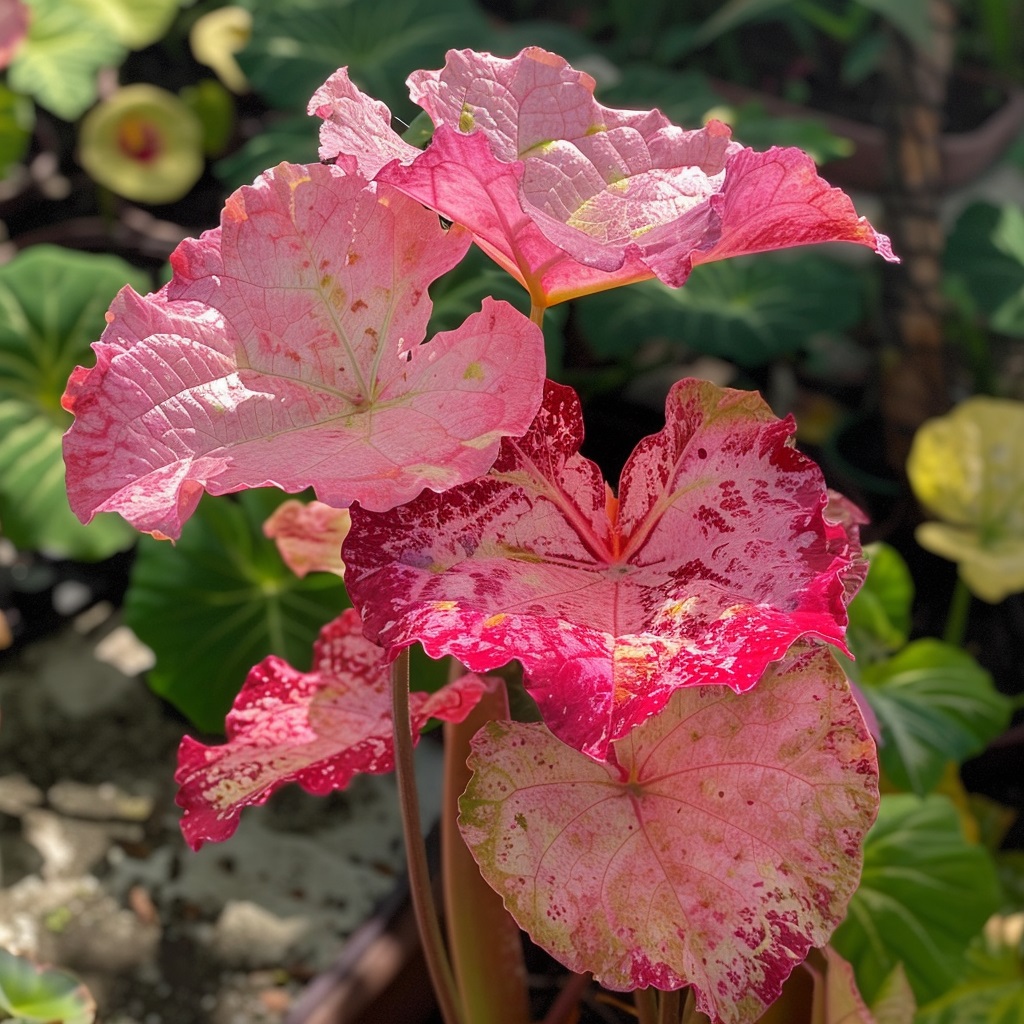
Cultural Importance in Tropical Ecosystems
In their native habitats, caladiums play an important role in the ecosystem. They are part of the understory vegetation in tropical forests, contributing to biodiversity and providing shelter for small animals and insects. The large leaves of caladiums help to maintain soil moisture by reducing evaporation and can aid in preventing soil erosion in forest environments.
Indigenous cultures have traditionally used caladiums for various purposes beyond their ornamental value. Some tribes have utilized parts of the plant in traditional medicine, though it’s important to note that caladiums contain calcium oxalate crystals, which can be toxic if ingested.
In modern horticulture, caladiums serve as ambassadors for tropical ecosystems, allowing people in various climates to experience a piece of the rainforest in their own gardens. This connection can foster a greater appreciation for tropical biodiversity and the importance of conservation efforts in these regions.
Understanding the Biology of Caladiums
Botanical Classification
Caladiums belong to the family Araceae, a diverse group of flowering plants that includes over 3,700 species across 114 genera. Within this family, caladiums are part of the subfamily Aroideae and the tribe Caladieae. The genus Caladium comprises about 17 accepted species, with Caladium bicolor being the most commonly cultivated.
The scientific classification of caladiums is as follows:
- Kingdom: Plantae
- Division: Angiosperms
- Class: Monocots
- Order: Alismatales
- Family: Araceae
- Subfamily: Aroideae
- Tribe: Caladieae
- Genus: Caladium
This classification places caladiums in close relation to other popular ornamental plants like philodendrons, anthuriums, and alocasias, all of which share similar growing requirements and characteristics.

Varieties and Their Unique Features
The world of caladiums is vast and diverse, with over 1,000 named cultivars available. These varieties are often categorized based on their leaf characteristics and growth habits. Some of the main categories include:
- Fancy Leaf Caladiums: These have large, heart-shaped leaves and are typically taller, reaching heights of 12 to 30 inches. Examples include ‘White Queen’ and ‘Red Flash’.
- Strap Leaf Caladiums: Characterized by narrower, elongated leaves, these varieties are usually more compact and sun-tolerant. ‘Florida Sweetheart’ and ‘White Wing’ are popular strap leaf cultivars.
- Dwarf Caladiums: These compact varieties are perfect for container gardens or as border plants. ‘Mini White’ and ‘Red Ruffles’ are examples of dwarf caladiums.
Each variety offers unique color combinations and patterns. For instance, ‘Candidum’ features white leaves with green veins, while ‘Postman Joyner’ boasts deep red leaves with green edges. The ‘Thai Beauty’ series, developed in Thailand, offers striking patterns and vibrant colors that push the boundaries of traditional caladium aesthetics.
Photosynthesis and Growth Patterns
Caladiums have adapted to thrive in low-light conditions, a characteristic that sets them apart from many other colorful plants. Their large leaves are efficient at capturing available light, allowing them to photosynthesize effectively even in shaded environments.
The growth pattern of caladiums is heavily influenced by temperature and daylight hours. In optimal conditions, new leaves emerge from the underground tuber, unfurling to reveal their vibrant colors and patterns. As the growing season progresses, caladiums will continue to produce new leaves, with older leaves eventually dying off.
Interestingly, caladiums exhibit a form of dormancy in response to cooler temperatures or reduced daylight hours. In temperate climates, this often occurs in autumn, signaling gardeners to dig up and store the tubers for winter. In their native tropical habitats, this dormancy might be less pronounced or triggered by dry seasons rather than cold.
Understanding these biological aspects of caladiums is crucial for successful cultivation and appreciation of these remarkable plants. Their unique adaptations to low-light environments and their diverse array of leaf forms and colors make them not only beautiful garden additions but also fascinating subjects for botanical study.

Ideal Growing Conditions for Caladiums
Climate Preferences and Temperature Ranges
Caladiums are tropical plants that thrive in warm, humid conditions reminiscent of their native habitats. Understanding their climate preferences is crucial for successful cultivation:
- Temperature: Caladiums prefer temperatures between 70°F and 85°F (21°C to 29°C). They are sensitive to cold and can be damaged or enter dormancy when temperatures drop below 60°F (15°C).
- Humidity: High humidity levels, ideally between 50% and 80%, are optimal for caladiums. In drier climates, regular misting or the use of humidity trays can help maintain the moisture levels these plants crave.
- Hardiness Zones: In the United States, caladiums are typically grown as perennials in USDA Hardiness Zones 9-11. In cooler zones, they are often treated as annuals or grown in containers that can be moved indoors during colder months.
Gardeners in temperate climates should plant caladiums after the last frost date in spring when soil temperatures have warmed to at least 65°F (18°C). In tropical and subtropical regions, caladiums can be planted year-round, though growth may slow during cooler or drier periods.
Soil Composition and Drainage Requirements
The right soil composition is essential for healthy caladium growth:
- Soil Type: Caladiums prefer rich, well-draining soil that retains moisture without becoming waterlogged. A mixture of loamy soil, peat moss, and perlite or sand can create an ideal growing medium.
- pH Level: Aim for a slightly acidic to neutral pH, ideally between 5.5 and 6.5. This range allows for optimal nutrient uptake by the plants.
- Organic Matter: Incorporating organic matter such as compost or well-rotted manure can improve soil structure and provide essential nutrients.
- Drainage: While caladiums enjoy consistent moisture, they are susceptible to root rot in poorly drained soils. Ensure that the planting area has good drainage, or consider raised beds or mounds if the native soil is heavy clay.
When planting in containers, use a high-quality potting mix designed for tropical plants, and ensure that pots have adequate drainage holes.

Light Exposure: Shaded vs. Direct Sunlight
Caladiums are renowned for their ability to bring color to shaded areas, but their light requirements can vary depending on the variety:
- Shade-Loving Varieties: Most fancy leaf caladiums prefer partial to full shade. They thrive in locations that receive filtered sunlight or morning sun with afternoon shade. Too much direct sunlight can cause leaf burn and color fading.
- Sun-Tolerant Varieties: Some strap leaf and newer hybrid varieties can tolerate more sun exposure. These types often have thicker leaves and more intense colors that hold up better in brighter conditions.
- Indoor Lighting: When grown indoors, caladiums do well in bright, indirect light. A north or east-facing window often provides ideal conditions.
- Adapting to Light Conditions: The intensity of leaf color can be influenced by light exposure. In deeper shade, leaves may appear more vibrant, while in brighter light, colors might be slightly muted but the overall plant may be more compact and sturdy.
It’s important to observe your caladiums and adjust their placement if needed. Signs of inadequate light include elongated, spindly growth and dull leaf colors. Conversely, crispy or bleached leaves may indicate too much direct sunlight.
By carefully considering these growing conditions – climate, soil, and light exposure – gardeners can create an environment where caladiums not only survive but thrive, showcasing their full potential as living works of art in the landscape.
The Art of Planting Caladiums
Choosing the Right Location in Your Garden
Selecting the perfect spot for your caladiums is crucial for their health and visual impact:
- Assess Light Conditions: Observe your garden throughout the day to identify areas that receive dappled sunlight or partial shade. Remember that light conditions can change with the seasons as deciduous trees leaf out or lose foliage.
- Consider Microclimates: Look for protected areas that offer higher humidity and shelter from strong winds. Areas near water features or under the canopy of larger plants can create ideal microclimates for caladiums.
- Soil Quality: Test the soil in potential planting areas for drainage and pH levels. Amend the soil as necessary to create the rich, well-draining environment caladiums prefer.
- Visual Design: Think about how caladiums will fit into your overall garden design. They can be excellent focal points, add depth to borders, or create striking color contrasts with other plants.
- Accessibility: Plant caladiums where you can easily enjoy their beauty and access them for maintenance. Consider placing them near paths or seating areas for maximum impact.

Techniques for Successful Planting
Once you’ve chosen the perfect location, follow these steps for planting:
- Timing: Plant caladiums in spring after the soil has warmed to at least 65°F (18°C). In warmer climates, you can plant them earlier or even year-round.
- Soil Preparation: Loosen the soil to a depth of 8-10 inches and incorporate organic matter to improve structure and fertility.
- Planting Depth: Plant tubers about 1-2 inches deep, with the bumpy side facing up. Space them 6-12 inches apart, depending on the variety and desired fullness.
- Watering: Water thoroughly after planting and keep the soil consistently moist but not waterlogged as the plants establish.
- Mulching: Apply a 2-3 inch layer of organic mulch around the plants to help retain moisture and suppress weeds. Keep the mulch a few inches away from the stems to prevent rot.
- Fertilization: Apply a balanced, slow-release fertilizer at planting time to provide nutrients throughout the growing season.
Companion Planting: Best Plants to Pair with Caladiums
Companion planting can enhance the beauty of your caladiums and create a harmonious garden ecosystem:
- Shade-Loving Companions: Pair caladiums with other shade-loving plants like hostas, ferns, and impatiens. The contrasting textures and forms can create visually interesting compositions.
- Complementary Colors: Use plants with flowers or foliage that complement or contrast with your caladium varieties. For example, pair white-leaved caladiums with purple-leaved heucheras or pink caladiums with blue-flowered lobelias.
- Vertical Interest: Combine caladiums with taller shade plants like coleus or begonias to create layers and add vertical interest to your garden beds.
- Ground Covers: Use low-growing plants like ajuga or creeping Jenny as ground covers around caladiums to create a lush, full look.
- Tropical Themes: For a tropical feel, pair caladiums with other heat-loving plants like cannas, elephant ears, or bromeliads.
- Container Combinations: In pots, combine caladiums with trailing plants like sweet potato vine or ivy to create stunning container gardens.
Remember to consider the growth habits and care requirements of companion plants to ensure they are compatible with your caladiums. By thoughtfully combining plants, you can create a garden that is not only beautiful but also supports a diverse and healthy ecosystem.

Care and Maintenance of Caladiums
Watering Practices: Achieving Consistent Moisture
Proper watering is crucial for the health and vibrancy of caladiums:
- Frequency: Water caladiums when the top inch of soil feels dry to the touch. This usually translates to watering every 2-3 days, depending on climate and soil conditions.
- Method: Water deeply at the base of the plants, avoiding wetting the leaves to prevent fungal diseases. Soaker hoses or drip irrigation systems can be effective for maintaining consistent moisture.
- Moisture Meter: Consider using a moisture meter to accurately gauge soil moisture levels, especially when first learning to care for caladiums.
- Seasonal Adjustments: Increase watering frequency during hot, dry periods and reduce it during cooler or rainy seasons. Always avoid waterlogging the soil.
- Container Considerations: Potted caladiums may require more frequent watering as containers tend to dry out faster than garden soil.
Fertilization: Nutrient Needs Throughout the Seasons
Caladiums benefit from regular fertilization to maintain their lush growth and vibrant colors:
- Initial Feeding: Apply a balanced, slow-release fertilizer (e.g., 10-10-10) at planting time.
- Growing Season: Feed monthly with a water-soluble fertilizer high in nitrogen to promote leafy growth. A ratio like 20-10-20 or 15-5-15 is ideal.
- Late Season: Reduce fertilization as autumn approaches to prepare the plants for dormancy. In regions where caladiums grow year-round, continue feeding but at a reduced rate during slower growth periods.
- Organic Options: For organic gardening, use compost tea or fish emulsion as alternatives to synthetic fertilizers.
- Micronutrients: Ensure the fertilizer includes micronutrients like iron and magnesium, which are important for healthy leaf development and coloration.
Pruning and Deadheading for Optimal Growth
While caladiums don’t require extensive pruning, some maintenance can enhance their appearance and health:
- Removing Old Leaves: Cut off any yellowing or damaged leaves at the base to maintain the plant’s attractive appearance and redirect energy to new growth.
- Promoting Bushiness: If plants become leggy, consider pinching back growing tips to encourage fuller growth.
- Flower Removal: Caladiums occasionally produce small, insignificant flowers. Remove these to focus the plant’s energy on foliage production.
- End-of-Season Care: In areas where caladiums are not winter-hardy, cut back foliage after the first frost and dig up tubers for winter storage.
- Cleaning Tools: Always use clean, sharp tools when pruning to prevent the spread of diseases.
By following these care and maintenance practices, you can ensure that your caladiums remain healthy and vibrant throughout the growing season, providing a stunning display of colorful foliage in your garden or indoor spaces.

Common Pests and Diseases Affecting Caladiums
Identifying Common Pests: Aphids, Spider Mites, and More
Caladiums, while generally hardy, can fall victim to several pests. Early identification and treatment are key to maintaining plant health:
- Aphids: These small, soft-bodied insects cluster on new growth and undersides of leaves. They can cause distorted growth and secrete a sticky substance called honeydew.
- Spider Mites: Tiny arachnids that feed on plant sap, spider mites can cause stippling and webbing on caladium leaves, leading to reduced vigor.
- Mealybugs: White, cottony insects that congregate in leaf axils and stems, mealybugs can weaken plants by draining sap and excreting honeydew, promoting sooty mold growth.
- Thrips: These slender insects feed by rasping plant tissue, causing silvering or stippling on leaves. They can also transmit viruses to caladiums.
- Scale Insects: Hard, shell-like coverings protect scale insects as they feed on plant fluids. Infestations can lead to yellowing, wilting, and stunted growth in caladiums.
Disease Management: Fungal and Bacterial Issues
In addition to pests, caladiums are susceptible to various diseases that can impact their health and appearance:
- Leaf Spot: Fungal pathogens like Cercospora spp. can cause circular, brown spots with yellow halos on caladium leaves. Remove and destroy infected foliage to prevent spread.
- Rhizome Rot: Excess moisture or poor drainage can lead to fungal infections in caladium rhizomes, causing rot and eventual plant death. Avoid overwatering and ensure proper soil drainage.
- Powdery Mildew: A common fungal disease, powdery mildew appears as a white, powdery coating on leaves. Improve air circulation and avoid overhead watering to reduce humidity levels.
- Bacterial Blight: Erwinia chrysanthemi is a bacterial pathogen that causes water-soaked lesions on caladium leaves, which may ooze and turn brown. Remove and destroy affected plant parts promptly.
- Fusarium Wilt: This soilborne fungal disease can cause wilting, yellowing, and stunting in caladiums. Practice crop rotation and avoid planting in contaminated soil to prevent its spread.
Preventative Measures to Protect Your Caladiums
To safeguard your caladiums from pests and diseases, consider implementing these preventative strategies:
- Regular Inspection: Monitor your plants frequently for signs of pest infestations or disease symptoms. Early detection allows for prompt intervention.
- Cultural Practices: Maintain good garden hygiene by removing debris, fallen leaves, and weeds that can harbor pests and pathogens.
- Proper Watering: Avoid overwatering, which can create conditions favorable for fungal diseases. Water at the base of plants in the morning to allow foliage to dry during the day.
- Air Circulation: Space caladiums adequately to promote airflow, reducing humidity levels and minimizing the risk of fungal infections.
- Quarantine New Plants: Before introducing new plants to your garden, inspect them thoroughly for pests and diseases. Keep them separate for a period to monitor their health before integrating them with existing vegetation.
By staying vigilant, practicing good gardening habits, and addressing issues promptly, you can help your caladiums thrive and resist common pests and diseases, ensuring their longevity and beauty in your garden.
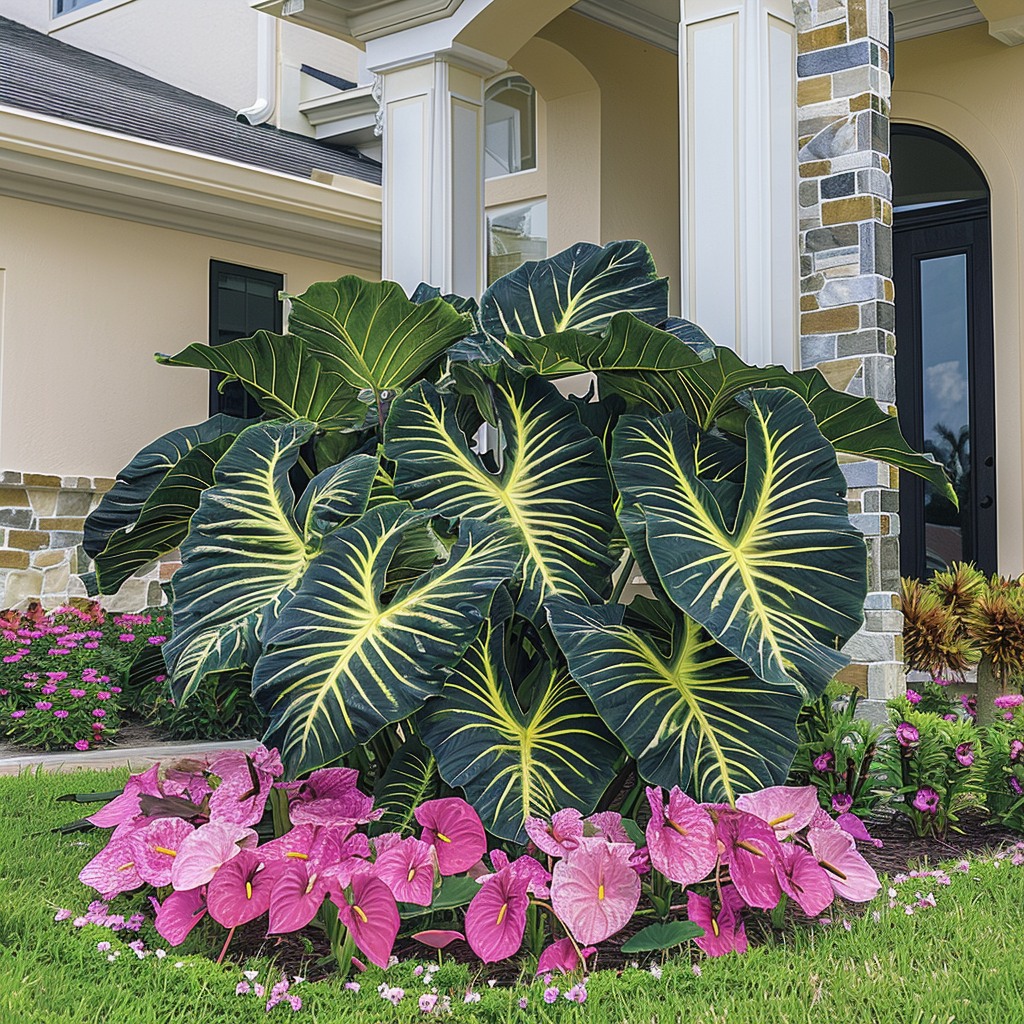
Propagating Caladiums
Techniques for Dividing Bulbs
Propagating caladiums through bulb division is a simple and effective method to increase your plant collection:
- Timing: Divide caladium bulbs in early spring before new growth emerges or in late autumn after foliage dies back.
- Digging Up Bulbs: Carefully dig up the caladium clump, taking care not to damage the tubers. Shake off excess soil to expose the bulbs.
- Division: Gently pull apart the individual tubers, ensuring each division has at least one growth point or “eye” for future sprouting.
- Replanting: Plant the divided tubers in prepared soil at the appropriate depth, water thoroughly, and provide optimal growing conditions.
- Patience: Newly divided caladiums may take some time to establish and resume active growth. Be patient and continue to provide care as needed.
Seed Propagation: Tips and Tricks
While less common, caladiums can also be propagated from seeds, although this method requires more time and patience:
- Seed Collection: Harvest mature caladium seeds from the plant’s flowers when they develop seed pods. Allow the pods to dry before collecting the seeds.
- Seed Starting: Sow caladium seeds in a well-draining, moist seed-starting mix. Cover lightly with soil and maintain consistent moisture levels.
- Germination: Place the seed tray in a warm, bright location, keeping the soil consistently moist. Germination can take several weeks to months, so be patient.
- Transplanting: Once seedlings have developed several true leaves, transplant them into individual pots or a prepared garden bed, spacing them appropriately.
- Growth and Care: Provide seedlings with adequate light, water, and nutrients as they grow. Monitor their progress and adjust care as needed to support healthy development.
Timing and Seasonal Considerations
Whether propagating caladiums through bulb division or seeds, timing and seasonal factors play a crucial role in successful propagation:
- Spring Division: Dividing caladium bulbs in spring allows the newly separated tubers to establish and grow during the active growing season.
- Autumn Division: Fall division is ideal for regions where caladiums go dormant in winter, giving the divisions time to settle in before cold weather arrives.
- Seed Starting: Begin sowing caladium seeds indoors in late winter to early spring to provide a head start on the growing season. Outdoor sowing can follow once the danger of frost has passed.
- Growth Cycle: Understanding the natural growth cycle of caladiums helps determine the best times for propagation, ensuring that new plants have optimal conditions for development.
- Patience and Persistence: Propagation can sometimes be a trial-and-error process, so don’t be discouraged by initial setbacks. With practice and experience, you’ll become more adept at multiplying your caladium collection.
By exploring different propagation methods and adapting them to suit your local climate and growing conditions, you can enjoy the satisfaction of creating new caladium plants to enrich your garden or indoor spaces.

Decorative Uses of Caladiums in Gardens
Designing Colorful Borders with Caladiums
Caladiums are prized for their vibrant foliage, making them excellent choices for creating eye-catching borders in garden beds:
- Color Coordination: Select caladium varieties with foliage colors that complement or contrast with surrounding plants to create visually appealing combinations.
- Height Variation: Use taller caladium cultivars towards the back of borders and shorter ones towards the front to create a sense of depth and dimension.
- Edge Planting: Line garden borders with caladiums to define pathways or separate different sections of the landscape, adding structure and visual interest.
- Seasonal Displays: Rotate caladiums with other seasonal plants to maintain year-round interest in your garden borders, changing the color palette with each planting.
- Maintenance Considerations: When designing borders with caladiums, factor in their care requirements, such as watering and fertilization needs, to ensure the plants thrive in their designated space.
Creating Focal Points in Landscaping
Caladiums can serve as striking focal points in landscaping designs, drawing attention and adding a touch of elegance to outdoor spaces:
- Centerpiece Planting: Position a large, showy caladium cultivar in the center of a flower bed or container arrangement to anchor the design and create a focal point.
- Accent Plantings: Use groups of caladiums strategically placed throughout the landscape to draw the eye and add pops of color amidst greenery or flowering plants.
- Container Specimens: Showcase individual caladium plants in decorative containers on patios, porches, or outdoor living areas to bring color and texture to these spaces.
- Architectural Complements: Pair caladiums with structures like arbors, trellises, or garden sculptures to enhance the overall aesthetic and create cohesive design elements.
- Lighting Effects: Experiment with lighting to highlight caladiums as focal points in the evening or nighttime garden, adding drama and ambiance to the outdoor environment.
Incorporating Caladiums into Container Gardens
Caladiums are versatile plants that adapt well to container cultivation, allowing for creative arrangements in small spaces or on patios and balconies:
- Container Selection: Choose pots or containers with drainage holes to prevent waterlogging, selecting sizes that accommodate the mature growth of caladiums.
- Soil Mix: Use a well-draining potting mix rich in organic matter to provide the necessary nutrients and aeration for healthy caladium growth in containers.
- Thriller, Filler, Spiller: Follow the classic container gardening formula by incorporating caladiums as the thriller (tall centerpiece), surrounded by filler plants, and trailing spillers for a balanced look.
- Seasonal Displays: Rotate caladium containers with other seasonal plants to keep displays fresh and interesting throughout the year, adapting to changing weather conditions.
- Maintenance Routine: Regularly check container-grown caladiums for water and nutrient needs, adjusting care as necessary to ensure they remain vibrant and flourishing in their confined environment.
By integrating caladiums into various aspects of your garden design, from borders and focal points to container arrangements, you can harness the plant’s ornamental qualities to elevate the aesthetics of your outdoor spaces and create visually captivating landscapes.

Psychological Benefits of Gardening with Caladiums
Caladiums and Mental Health: Reducing Stress
Engaging with nature through gardening, particularly with plants like caladiums, can have a positive impact on mental well-being:
- Therapeutic Activities: Tending to caladiums, whether planting, watering, or pruning, provides a calming and meditative experience that reduces stress and anxiety.
- Connection to Nature: Cultivating a garden with caladiums fosters a sense of connection to the natural world, promoting mindfulness and grounding in the present moment.
- Creative Expression: Designing and caring for gardens with caladiums allows for creative expression and personalization, offering a fulfilling outlet for self-expression.
- Sense of Accomplishment: Watching caladiums thrive and flourish under your care instills a sense of accomplishment and pride, boosting self-esteem and confidence.
- Outdoor Therapy: Spending time outdoors in the garden, surrounded by the beauty of caladium foliage, promotes relaxation, rejuvenation, and a break from the demands of daily life.
Mindfulness Practices in Garden Spaces
Gardening with caladiums provides an opportunity to practice mindfulness, focusing on the present moment and immersing oneself in the sensory experience:
- Sensory Engagement: Engage all your senses while gardening with caladiums, from feeling the soil between your fingers to inhaling the earthy scents of the garden.
- Observational Awareness: Pay close attention to the growth patterns, colors, and textures of caladium foliage, observing changes over time and appreciating the beauty of nature’s cycles.
- Emotional Regulation: Gardening with caladiums can help regulate emotions, providing a therapeutic outlet for processing feelings and finding moments of peace and tranquility.
- Stress Relief: The repetitive tasks involved in caring for caladiums, such as watering or weeding, can act as stress-relieving rituals that promote relaxation and mental clarity.
- Gratitude Practice: Cultivate gratitude for the beauty and abundance that caladiums bring to your life, fostering a positive mindset and appreciation for the natural world.
The Aesthetic Appeal of Vibrant Foliage
Caladiums are celebrated for their stunning foliage, which not only enhances outdoor spaces but also uplifts moods and creates visual delight:
- Color Psychology: The vibrant hues and intricate patterns of caladium leaves can evoke different emotions and energies, influencing the atmosphere of garden environments.
- Visual Stimulation: The bold contrasts and variegation in caladium foliage provide visual interest and focal points in garden settings, captivating the eye and sparking curiosity.
- Seasonal Transitions: As caladiums change with the seasons, transitioning from dormancy to lush growth, they reflect the cyclical nature of life and offer opportunities for reflection and renewal.
- Artistic Inspiration: The artistic qualities of caladium foliage inspire creativity and imagination, encouraging gardeners to experiment with color combinations and design concepts in their landscapes.
- Natural Beauty: Above all, the sheer beauty of caladiums, with their painterly leaves and graceful forms, brings joy and pleasure to those who appreciate the wonders of the botanical world.
By immersing yourself in the beauty of caladiums and engaging with them mindfully in garden spaces, you can reap the psychological benefits of connecting with nature and revel in the artistry of these exquisite plants.
Conservation and Sustainability Considerations
Ethical Sourcing of Caladiums
When acquiring caladium plants or bulbs, it’s essential to consider ethical sourcing practices to support sustainable cultivation and conservation efforts:
- Certified Suppliers: Purchase caladiums from reputable nurseries or suppliers that adhere to responsible growing practices and prioritize plant health and environmental stewardship.
- Local Production: Whenever possible, choose locally grown caladiums to reduce carbon footprint and support regional horticultural businesses and economies.
- Organic Options: Opt for organically grown caladiums to minimize exposure to synthetic pesticides and fertilizers, promoting ecological balance and soil health.
- Wild Harvesting Awareness: Be mindful of caladium species that are harvested from the wild for commercial purposes, as this practice can threaten native populations and ecosystems.
- Conservation Contributions: Support organizations and initiatives dedicated to conserving caladium species in their natural habitats, contributing to biodiversity preservation and habitat protection.
Impact of Cultivation on Native Habitats
While caladiums are primarily cultivated for ornamental purposes, it’s important to consider the potential impacts of their cultivation on native habitats and ecosystems:
- Invasive Potential: Some caladium species, if introduced to non-native environments, may exhibit invasive tendencies, outcompeting native flora and disrupting local ecosystems.
- Genetic Diversity: Intensive cultivation of a limited range of caladium varieties can reduce genetic diversity within populations, making them more vulnerable to pests, diseases, and environmental changes.
- Pollinator Support: Encourage pollinator-friendly gardening practices alongside caladium cultivation to provide food and habitat for bees, butterflies, and other beneficial insects.
- Water Conservation: Implement water-wise gardening techniques when growing caladiums to reduce water consumption and minimize strain on local water resources, especially in arid regions.
- Habitat Restoration: Consider incorporating native plant species alongside caladiums in garden designs to support local wildlife and contribute to ecosystem restoration efforts.
Promoting Biodiversity Through Responsible Gardening
By adopting sustainable and biodiversity-conscious gardening practices, you can contribute to the conservation of plant species like caladiums and promote ecological resilience:
- Native Plant Integration: Include native plant species in your garden alongside caladiums to create diverse habitats that support local wildlife and enhance ecosystem health.
- Habitat Creation: Design garden spaces that mimic natural ecosystems, providing food, shelter, and breeding sites for a variety of plant and animal species, including pollinators and beneficial insects.
- Chemical-Free Solutions: Embrace organic gardening methods and natural pest control measures to minimize the use of synthetic chemicals that can harm beneficial organisms and disrupt ecological balance.
- Education and Advocacy: Share knowledge about the importance of biodiversity and sustainable gardening practices with others, advocating for conservation efforts and community engagement in environmental stewardship.
- Long-Term Planning: Plan your garden with consideration for long-term sustainability, focusing on soil health, water efficiency, and plant diversity to create resilient and thriving ecosystems over time.
By cultivating caladiums and other plants mindfully, with a commitment to conservation and sustainability, you can enjoy the beauty of nature while actively contributing to the preservation of biodiversity and the health of our planet.
Conclusion
In conclusion, caladiums stand out as nature’s living artwork, captivating gardeners with their vibrant foliage and ornamental charm. From understanding the biology and ideal growing conditions of caladiums to exploring their decorative uses in gardens and the psychological benefits of gardening with these plants, there is much to appreciate and learn about these botanical treasures.
By delving into the care and maintenance practices, propagation techniques, and considerations for conservation and sustainability, we can cultivate caladiums responsibly and ethically, nurturing both the plants themselves and the ecosystems they inhabit. Through mindful gardening practices and a deep appreciation for the beauty and diversity of caladiums, we can create harmonious garden spaces that not only delight the senses but also support the interconnected web of life on Earth.
So, whether you’re a seasoned gardener looking to expand your plant palette or a beginner eager to explore the world of caladiums, let these colorful companions inspire you to cultivate beauty, foster biodiversity, and cultivate a deeper connection to the natural world around you. Happy gardening, and may your journey with caladiums be filled with joy, creativity, and a profound appreciation for the wonders of nature.
